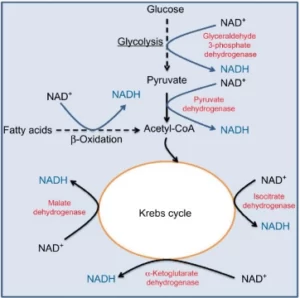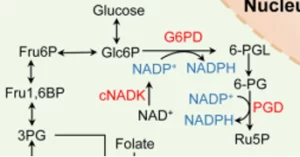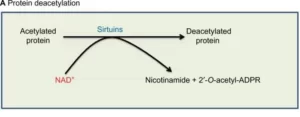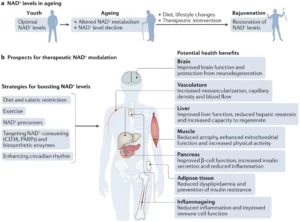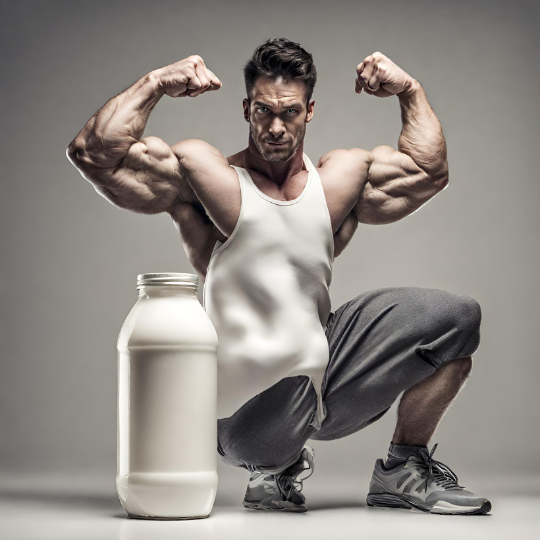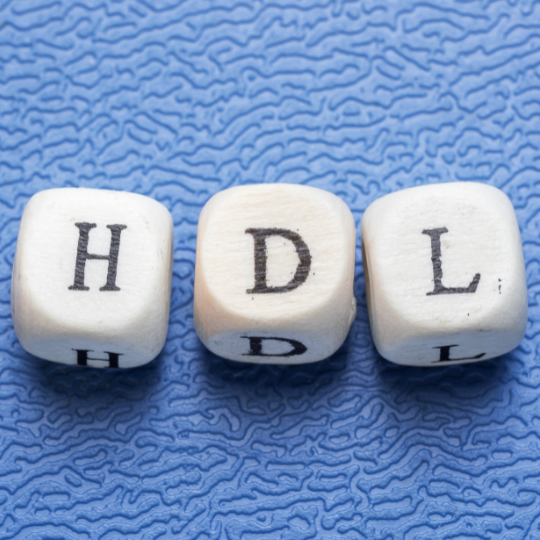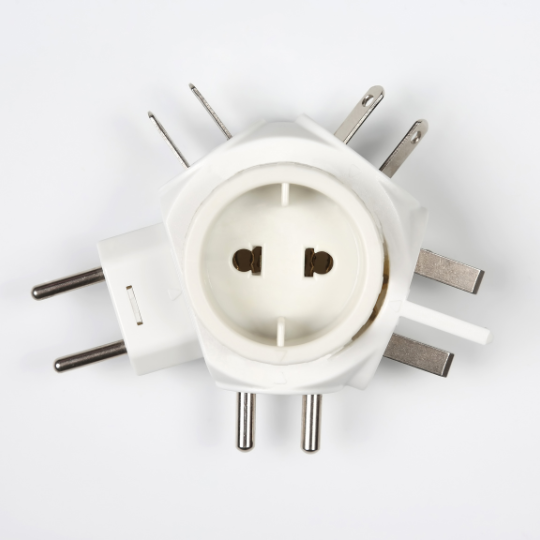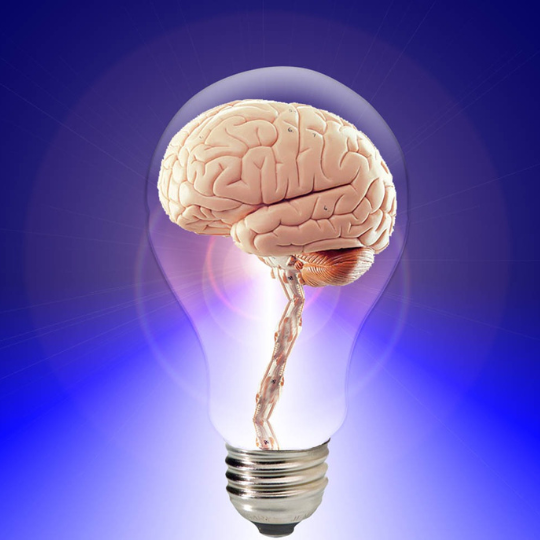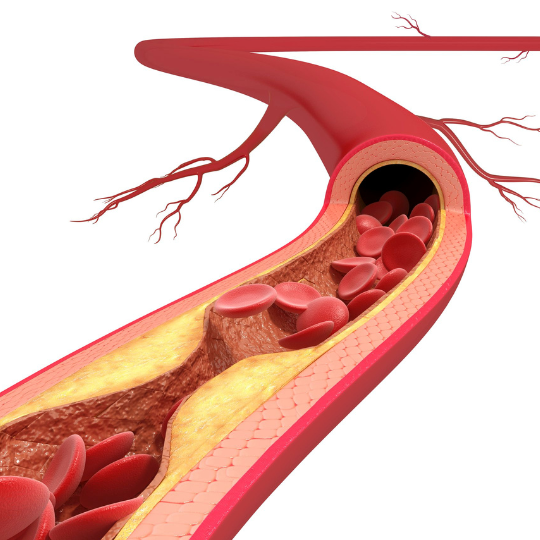NAD+ and NADH are important cofactors in the body and play crucial roles in metabolism and antioxidant defense. Nicotinamide adenine dinucleotide (NAD+) is a molecule essential for redox reactions; it is also a cofactor or substrate of hundreds of enzymes and therefore it has multiple roles in the regulation of cellular processes and cellular functions. The ability of NAD+ to accept a hydride ion (H-), derives to its reduced version, NADH. NADH is critical for metabolic reactions, such as glycolysis, glutaminolysis and fatty acid oxidation.
More specifically, the accepted electrons in these reactions are then donated to the electron transport chain to form ATP, the cell’s energy currency. (Covarrubias et al., 2021)
NADP+ (Nicotinamide adenine dinucleotide phosphate) and NADPH (reduced version of NADP+) are similar to NAD+ and NADH, but they have completely different roles in the body. NADPH is a well-known essential electron donor and an indispensable cofactor that is used for transferring and reserving reduction potential for numerous anabolic reactions, such as formation of cholesterol, fatty acids, and steroids. NADPH is also a very powerful antioxidant that plays a key role in cellular antioxidation systems, this helps to prevent cancer and other diseases (Ju et al., 2020).
NAD+ & NADH in the mitochondria
NAD+ and NADH are key molecules during the Krebs Cycle (aka the citric acid or TCA cycle), the origin of energy inside the cells. It occurs inside the mitochondria and is responsible for generating energy in the form of ATP. During this cycle, NAD+ is used to accept electrons from the breakdown of nutrients, while NADH carries these electrons to the electron transport chain, where they are used to generate our much-wanted ATP (Wu et al., 2016).
NADP+ & NADPH in the genes
Yes, everything alters your gene expression (you must have that clear if you have read our older posts).
NADP+ and NADPH are important in the Pentose Phosphate Pathway (PPP). PPP which is a series of reactions that produces NADPH and generates ribose-5-phosphate, a key component of DNA and RNA. During this process, NADPH is produced through the reduction of NAPH+ (Ju et al., 2020).
NADPH and cholesterol
NADPH is also important in the synthesis of cholesterol and other lipids through a process called the Mevalonate pathway. In this pathway, NADPH is used to reduce 3-hydroxy-3-methylglutaryl-CoA (HMG-CoA) to mevalonate, which then is catabolized into cholesterol and other lipids.
Furthermore, NADHP is needed for the activity of cytochrome P450 reductase (POR), which is a major regulator in the metabolism of drugs, xenobiotics, and steroid hormones.
NAD+ & Sirtuins
Sirtuins are a class of enzymes that deacetylate specific proteins and alter their activity. Sirtuins have been shown to have a variety of effects on aging and longevity and NAD+ is involved in the regulation of gene expression through the action of these enzymes. Sirtuins use NAD+ for their deacetylation reactions; therefore if the NAD+ level is low, sirtuin protein content would be low. Why is this important? Well, it has been shown that acetylated proteins usually exhibit impaired functions, causing early aging and diseases.
One method to activate Sirtuins is by caloric restriction, as over-nutrition results in excess NADH and diminished NAD+, leading to an attenuation of the sirtuin protein content (Wu et al., 2016).
Genetic predispositions
Yes, genes again. There are several genes that are involved in the production and utilization of NAD+, NADH, NADP+ and NADPH in the body. Here are some examples of SNPs related to the function of these molecules:
- C242T CYBA polymorphism: related to altered NADPH oxidase activity in lymphoblastoid cells of patients with CVD (cardiovascular disease), leading to atherosclerosis. (Mehranpour et al., 2009).
- NADSYN1 polymorphism: involved in the production of NAD+ from tryptophan. SNPs in this gene might impair the NAD+ function. (Lin et al., 2021)
Lifestyle and longevity
NAD+ and NADP+ are very important molecules for being strong and healthy throughout a longevive lifespan. Here are some recommendations that might be beneficial for keeping the balance of NAD+ to NADH and of NADP+ to NADPH:
- Caloric restriction: Studies have shown that diet and caloric restriction are beneficial for boosting NAD+ levels, but remember to always contact a professional to set this up in a healthy, sustainable way. Our services, based on genetic science, can help you with this process.
- Exercise: yes, you may be tired of hearing how important physical activity is. But it is! Our bodies are made to move, so start walking, running, dancing, swimming or doing any activity that keeps you moving and grooving.
- NAD+ precursors: there are some supplements that may help boost NAD+ levels. Some of these precursors are Nicotinamide riboside (NR), nicotinamide mononucleotide (NMN), Nicotinic acid (NA), among others. Before starting supplementing with them, contact a professional for dosages suitable for you.
- Nutrition and genes: we recommend genetic testing to see if you have some SNP that may affect your NAD+ and NADP+ metabolism. In this way you can make optimal nutritional changes to improve your metabolic functions.
Now you are an expert to identify NAD+ and NADP+, their functions and how to improve your antioxidant levels. Follow our easy recommendations, keep a healthy active life and discover the benefits of keeping your natural antioxidant levels!
